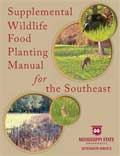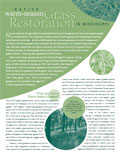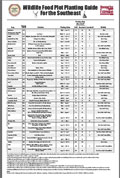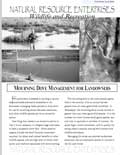Game Animals
Non-game Animals
Habitat
Food Plots
- Should be integrated with an overall habitat management plan for best results
- Site selection and plant selection is important
- Size of the plot is dependent upon the species you are trying to attract
Wildlife Food Plots or Supplemental Plantings
Planting food supplements or forages can benefit many species including turkey, mourning doves, bobwhite quail and white-tailed deer. Knowing which forage to plant and when to plant is essential when seeking to benefit wildlife in an area.
Food plots must be located near where wildlife seek cover. Prime locations include near brushy areas, corners of shrubby fence rows and wooded area edges. Ideal plot sizes are 1/4 to 1 acre for small game plots, and up to 5 acres for deer and turkey. Larger plots help protect from predators because the wildlife will not be concentrated in a small area. Plots should be long and at least 50 feet wide. Irregular shapes are preferable as they provide more edge.
Plantings should be chosen based on the type of wildlife landowners want to attract. For example, turkeys feed on soybeans, clovers and wheat while rabbits prefer warm season grass mixtures. Food plots should be carefully managed. Grain crops may need broadleaf weed control and legume plantings may require clipping and periodic reseeding.

Supplemental Wildlife Food Planting Manual for the Southeast (PDF)
Department of Forestry, Mississippi State University
This guide provides information on food plots and habitat management practices including disking, mowing and prescribed burning. The importance of openings is also discussed. A combination of supplemental forages in food planting is often necessary, as well as testing soil quality, fertilizing and liming. The location, size and shape of food plots as well as how to prepare them and which plants to use is included. An extensive guide on planting materials is given.

Soil Tests for Wildlife Food Plots (PDF)
Mississippi State University Extension Service
Having the proper fertility and type of soil affects the population, distribution and quality of wildlife. Testing of soil is necessary for landowners. This publication tells landowners where they can pick up and send soil testing kits and how to use them.

Native Warm-season Grass Restoration in Mississippi (PDF)
Mississippi State University Forest and Wildlife Research Center
This publication defines native warm season grasses, lists examples of the types of warm season grasses and provides labeled drawings of the types. It describes the benefits of restoring native grasses and how to do so. Information is provided on keeping different non-native grass species under control. Information is also given on choosing and planting grass species in a way that restores ecosystems and is advantageous to wildlife or creates livestock forage. Use of periodic disturbances is also covered along with contact information for organizations that assist with management of warm season grasses.

Managing the Family Forest in Mississippi (PDF)
Mississippi State University Extension Service
This table shows the type of crop, forage class, varieties, planting dates and rates, and wildlife species for different type of plantings.

Mourning Dove Management for Landowners (PDF)
Mississippi State University Extension Service, Natural Resource Enterprises
Managing fields for mourning dove hunting is a relatively cost effective natural-resource based enterprise that does not require large amounts of land. This publication discusses the population, mating habits and life history of mourning doves. Habitat requirements and food needs are covered as well planting food plots. Information on purchasing liability insurance and hunting regulations is provided as well as appropriate fees for hunting leases.
Supplemental Forage Management for East Texas White-tailed Deer (PDF)
Texas A&M University
Supplemental food plots should be used to improve the nutrition of deer and add critical minerals to the diet of a deer herd. This publication discusses the ecological regions of East Texas, how to plan, select a site, and select species for a food plot. It also covers the size and shape of food plots.
Establishing and Maintaining Wildlife Food Sources (PDF)
University of Florida IFAS Extension
Methods of increasing the production of different wildlife food sources are discussed including mast, food plantings and openings, and using forest management practices to increase food production in existing forests.
Establishing Wildlife Food Plots (PDF)
University of Arkansas Division of Agriculture
Food plots are often used to attract wildlife for viewing. Food plots can supplement wildlife nutrition when part of an overall wildlife management plan. This publication discusses how to get started with a food plot, the selection of plants, the nutritional needs of wildlife, types of plantings, seed mixtures, and where to plant.
Concepts of Soil Fertility for Hunter Food Plots (PDF)
Louisiana State University
Managing soil fertility affects how well plants grow and how nutritious they are. Testing your soil prior to planting a soil plot can make a difference in the quality and productivity of your plots. This publication covers how to take a soil sample, interpreting the results, adjusting pH, and applying fertilizer.
Seeding and Fertilization Rate Conversions for Wildlife Food Plots and Small Acres (PDF)
University of Arkansas Division of Agriculture
While traditional seeding and fertilization rates are given by the acre, most food plots are much smaller in size. This publication provides conversions of seeding and fertilizer rates from acre-sized fields to sub-acre fields per 1,000 square feet.

